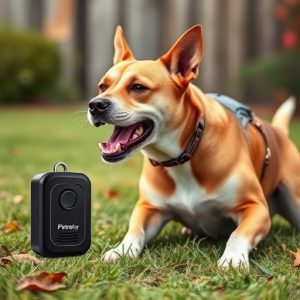Sound Wave Pet Control: Effective, Safe, or Just Noise?
Sound wave technology offers a humane, non-lethal approach to pet behavior control, particularly for…….
Sound wave technology offers a humane, non-lethal approach to pet behavior control, particularly for dogs with unwanted habits like barking or aggression. Handheld devices emit high-pitched sounds within a coverage area (typically 10-25 feet) unpleasant to dogs but inaudible to humans, encouraging them to avoid those areas and modify their behavior. These handheld dog deterrents, or ultrasonic pet trainers, are popular for their effectiveness and safety compared to shock collars. Selection should consider coverage area, frequency range, battery life, and sensitivity settings. While effective for many pets, results may vary based on species, noise interference, and weather conditions. Responsible use following manufacturer instructions is crucial to avoid harm.
“Unleash a new era in pet behavior management with sound wave technology, a innovative approach to training. This article delves into the potential of sound waves as a non-invasive control method for pets, focusing on dog deterrents. We explore ‘Coverage Area’ effectiveness, examining how these devices can manage spaces from backyards to parks. Handheld dog deterrents are scrutinized, highlighting their features and benefits. Additionally, we analyze advantages, disadvantages, and training considerations, empowering pet owners with comprehensive insights into this emerging field.”
- Understanding Sound Wave Technology for Pet Behavior Control
- The Coverage Area: How Effective is It?
- Handheld Dog Deterrents: A Comprehensive Look
- Advantages and Disadvantages of Using Sound Waves
- Training and Safety Considerations for Pet Owners
Understanding Sound Wave Technology for Pet Behavior Control
Sound wave technology has emerged as a innovative and non-lethal method for pet behavior control, particularly in managing dogs that exhibit unwanted behaviors like barking, aggression, or wandering. This technology utilizes specific frequencies and patterns of sound waves to influence an animal’s behavior without causing harm. The handheld dog deterrent devices operate within a targeted coverage area, emitting high-pitched sounds that are unpleasant to canines but generally inaudible to humans.
The effectiveness of sound wave pet behavior control lies in its ability to condition dogs to associate certain environments or situations with these specific sounds. Over time, the dogs learn to avoid areas where the deterrent is activated, thereby modifying their behavior. This approach offers a safe alternative to traditional methods involving shock collars or other physical deterrents, making it a popular choice for pet owners looking for humane solutions to manage their pets’ behaviors.
The Coverage Area: How Effective is It?
The effectiveness of a handheld dog deterrent, relying on sound waves to control behavior, largely depends on its coverage area. These devices emit high-frequency sounds that are generally inaudible to humans but can startle or deter dogs within a certain range. However, the practical utility is limited by space constraints – typically up to 10 meters (32 feet) from the device. Beyond this range, the sound waves may not be powerful enough to effectively reach and discourage canines.
In crowded spaces like parks or public events where multiple dogs might be present, a handheld dog deterrent’s coverage area becomes more critical. If not properly positioned or used in larger areas, it risks being ineffective for managing canine behavior. Thus, for optimal results, users must carefully consider the space they’re trying to control and ensure the device’s sound waves can effectively cover and reach their intended targets.
Handheld Dog Deterrents: A Comprehensive Look
Handheld dog deterrents, also known as ultrasonic pet trainers, have gained popularity as a humane and effective way to modify canine behavior. These devices emit high-frequency sound waves that are harmless to dogs but disrupt their attention and concentration, encouraging them to adjust their behavior accordingly. The coverage area of these handheld devices is typically around 50 feet (15 meters), making them suitable for both indoor and outdoor training sessions.
When choosing a handheld dog deterrent, it’s essential to consider factors like frequency range, battery life, and additional features such as adjustable sensitivity settings. Some models offer multiple frequencies to cater to different dog breeds and sensitivities, while others include remote controls for hands-free operation. Ensuring the device is easy to use and comfortable in your hand is also crucial for effective and consistent training sessions.
Advantages and Disadvantages of Using Sound Waves
Sound wave pet behavior control offers a unique and non-invasive approach to training and managing animal behavior, with several advantages. One of its key benefits is the ability to target specific animals within a defined coverage area. This technology can effectively deter problematic pets, such as dogs that bark excessively or cats that scratch furniture, without causing harm or stress. The handheld device allows for easy portability and convenience, enabling users to address issues in various settings, be it at home or in public spaces like parks.
However, there are also disadvantages to consider. Sound wave deterrents may not work on all animals; larger species or those with a low sensitivity to sound might not respond as expected. Additionally, the effectiveness can vary based on environmental factors, such as noise interference from surrounding areas or weather conditions. While it’s an innovative solution, users should be aware of its limitations and ensure it aligns with their specific needs and the behavior they aim to modify.
Training and Safety Considerations for Pet Owners
Training and safety should be paramount for pet owners considering sound wave pet behavior control devices, like handheld dog deterrents. These tools emit ultrasonic sounds that are inaudible to humans but can effectively correct unwanted behaviors like barking or aggression. However, proper training is crucial. Pet owners must learn how to activate and use the device effectively while also teaching their pets the association between the sound and desired behavior changes.
The coverage area of these devices varies by model, so it’s essential to choose one suitable for your space. Handheld deterrents typically have a limited range, usually up to 10-25 feet, making them ideal for specific training scenarios or smaller areas. Always follow manufacturer instructions and ensure the device is used responsibly and within safe limits to avoid any potential harm to both pets and humans.
In conclusion, sound wave technology offers a unique and non-invasive approach to pet behavior control. While the Coverage Area is an important factor to consider, especially with handheld dog deterrents, many owners find it effective in managing unwanted behaviors. The advantages, such as its safety and ease of use, make it an appealing option. However, understanding both the pros and cons, particularly during training, will ensure responsible and effective implementation for a peaceful coexistence between pets and their owners.


